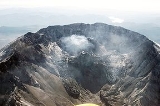
Crater Glacier
Encyclopedia
The Crater Glacier is a geologically young glacier
that is located on Mount Saint Helens, in the U.S. state
of Washington. The glacier formed after the 1980 Eruption
and due to its location, the body of ice grew rapidly, unknown to the public for nearly 20 years. The glacier once contained ice caves in the smooth ice before the post-2004 volcanic activity
. The growth of the lava dome and volcanic eruptions since 2004 significantly altered the appearance of the glacier. In the same time period, several agencies decided to put an official name on the glacier which, at first, was Tulutson Glacier. A later decision made Crater Glacier the official glacier name. Despite the volcanic activity, the glacier continued to advance and by mid-2008, the glacier completely encircled the lava domes. In addition, new glaciers (rock or ice) have formed around Crater Glacier as well.

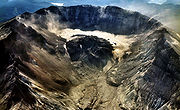 In the months after the eruption
In the months after the eruption
, the crater floor of Saint Helens remained hot and unstable, with five minor volcanic eruptions, and lava dome
construction between May and October 1980. After the eruptions ceased in the winter of 1980, the crater floor cooled down enough for snow and ice accumulation. Beginning with snowfall in the winter of 1980-1981, the glacier began to grow very rapidly in the shadow of the crater. The glacier thickened at a rate of as high as 50 ft (15 m) per year and advanced northward as much as 135 ft (41 m) a year. This glacier growth was discovered by scientists working in the crater about seven to nine years later. However, the existence of the glacier was not publicized until 1999. By 2004, Crater Glacier covered about 0.36 square mile (0.93 km²), about 20% of the glacier area in the pre-1980 glaciers, and there was a western and eastern lobe flowing around the 1980s dome. Due to the gas emissions on the crater floor, there were glacier cave
s (ice caves) in the once smooth glacial ice, and several of them had been explored by the late 1990s. With the volcanic activity
starting in 2004, the glacier lobes were pushed aside and higher by the growth of new volcanic domes. The surface of the glacier, once mostly uncrevassed, turned into a chaotic jumble of icefall
s heavily criss-crossed with crevasse
s and serac
s due to movement of the crater floor and lava dome growth. The new domes created since 2004 have almost split the Crater Glacier into two separate glaciers and melted 10% in volume of the glacier's ice. Cold rock on the edge of the glacier insulated the glacier ice from the 1300 °F (704.4 °C) lava spewing out of the lava dome, easing concerns of a catastrophic lahar
caused by glacier melting.
The thickness of the glacier continues to increase at a slower rate of 15 ft (5 m) per year. Despite the 2004-2008 volcanic activity, the termini of the glacier continue to advance at 3 ft (1 m) per day. By late-May 2008, the two arms of the glacier merged north of the lava dome.
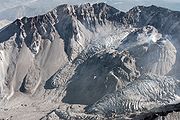 True to its name, the glacier lies inside the north-facing crater
True to its name, the glacier lies inside the north-facing crater
left by the 1980 eruption of Mount St. Helens
. A massive central lava dome emplaced from 1980 to 1987 occupies the center of the crater, and the glacier formed in the shape of a horseshoe
around the dome, with two terminal moraine
s on the eastern and western sides. The elevation of the glacier is about 6794 ft (2,071 m). Heavy winter snowfall, repeated snow avalanche
s, rockfall
s, and sun-shading by the surrounding cliffs to the south, led to the exceptionally rapid growth of this glacier. Thus, the glacier composition is estimated to be six-tenths ice and four-tenths rock. In addition, the glacier is very thick, averaging about 328 feet (100 m) with a maximum thickness of around 656 feet (200 m); nearly as deep as Mount Rainier's Carbon Glacier
. None of the ice
is older than the year 1980, however, the volume of the new glacier is about the same as all the pre–1980 glaciers combined. The surface of the glacier looks dark and dirty in the summer due to the numerous rockfalls from the steep, unstable crater walls along with ash from eruptions, all of which helps to insulate and protect the growing glacier. The 2004-2008 volcanic activity has created a new dome, which has split the glacier almost completely in half on the south end of the glacier. In spite of the four-year lava dome building period, the glacier remains North America
's youngest and fastest growing glacier. With the joining of the termini on the north end of Crater Glacier in May 2008, the body of ice completely encircles the lava dome. Meltwater from the glacier gives rise to Loowit Creek.
Pre-2004 eruption glacier caves of Crater Glacier
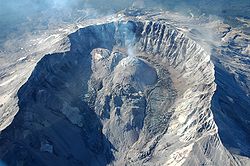 In 2000, glacier caves were discovered on the then-smooth glacier surface. Many of these glacier caves were big enough to explore, like the glacier caves on the summit of Mount Rainier
In 2000, glacier caves were discovered on the then-smooth glacier surface. Many of these glacier caves were big enough to explore, like the glacier caves on the summit of Mount Rainier
. Most of the glacier caves were located near the 1980s lava dome, where hot steam and volcanic gas emissions from hidden fumarole
s on the crater floor or lava dome melted holes in the young glacial ice. About 7,900 feet or 2.4 km of underground caves and passageways in the glacier were mapped and studied.
Other glaciers and new rock glaciers
Since 2004, new glaciers have formed on the crater wall above Crater Glacier feeding rock and ice to Crater Glacier below. In addition, there are two rock glacier
s to the north of the eastern lobe of Crater Glacier and one north of the western lobe.
Despite numerous observations and publications about the growing glacier in the late 1990s and early 2000s, no move was made to give the glacier a permanent and official name until late 2004, after the current eruptive cycle began and the new dome began to split the glacier. At that time, a proponent from the Cowlitz tribe
suggested the name "Tulutson Glacier," from the Cowlitz language
word for ice. In March 2005, the Washington State Board on Geographic Names chose Tulutson over three other contenders (Crater, Spirit, and Tamanawas),
and so Tulutson Glacier became the de facto name.
However, the U.S. Board on Geographic Names had yet to make its decision, which would be official throughout the United States. The name Tulutson Glacier was submitted for consideration, along with Crater Glacier and Kraffts Glacier, which would have honored the volcanologist
s Katia and Maurice Krafft
, killed by a pyroclastic flow
in 1991. In June 2006, the U.S. BGN chose Crater Glacier because of its two-decade precedent of common use, despite objections from the state of Washington and the United States Forest Service
which both preferred Tulutson. The scientists at the USGS Cascades Volcano Observatory strongly supported Crater Glacier, and also commented that Tulutson may not be an appropriate name since the volcano “lies inland in a region where the native language was not Cowlitz but Sahaptin
.”
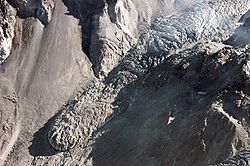 After the decision, some controversy erupted following an editorial in a local newspaper protesting the decision, and the state of Washington "has indicated that the name Tulutson Glacier will continue to appear on State products, although if the feature melts soon, as is anticipated, this may not be a great concern." Despite these protests, the glacier is now officially named the Crater Glacier, and it continues to expand even through the past two-and-half years of renewed volcanic activity. Since continued dome building has nearly split the glacier in two, shortly after their June 2006 decision the BGN received a follow-up proposal to name the two arms of the glacier, East Crater Glacier and West Crater Glacier, but no further action has been taken on this matter.
After the decision, some controversy erupted following an editorial in a local newspaper protesting the decision, and the state of Washington "has indicated that the name Tulutson Glacier will continue to appear on State products, although if the feature melts soon, as is anticipated, this may not be a great concern." Despite these protests, the glacier is now officially named the Crater Glacier, and it continues to expand even through the past two-and-half years of renewed volcanic activity. Since continued dome building has nearly split the glacier in two, shortly after their June 2006 decision the BGN received a follow-up proposal to name the two arms of the glacier, East Crater Glacier and West Crater Glacier, but no further action has been taken on this matter.
Glacier
A glacier is a large persistent body of ice that forms where the accumulation of snow exceeds its ablation over many years, often centuries. At least 0.1 km² in area and 50 m thick, but often much larger, a glacier slowly deforms and flows due to stresses induced by its weight...
that is located on Mount Saint Helens, in the U.S. state
U.S. state
A U.S. state is any one of the 50 federated states of the United States of America that share sovereignty with the federal government. Because of this shared sovereignty, an American is a citizen both of the federal entity and of his or her state of domicile. Four states use the official title of...
of Washington. The glacier formed after the 1980 Eruption
1980 eruption of Mount St. Helens
The 1980 eruption of Mount St. Helens, a stratovolcano located in Washington state, in the United States, was a major volcanic eruption. The eruption was the only significant one to occur in the contiguous 48 U.S. states since the 1915 eruption of Lassen Peak in California...
and due to its location, the body of ice grew rapidly, unknown to the public for nearly 20 years. The glacier once contained ice caves in the smooth ice before the post-2004 volcanic activity
2004 and later volcanic activity of Mount St. Helens
The 2004–2008 volcanic activity of Mount St. Helens has been documented as a continuous eruption with a gradual extrusion of magma at the Mount St. Helens volcano in Washington, United States. Starting in October 2004 and ceasing in January 2008, there was a gradual building of a new lava dome. ...
. The growth of the lava dome and volcanic eruptions since 2004 significantly altered the appearance of the glacier. In the same time period, several agencies decided to put an official name on the glacier which, at first, was Tulutson Glacier. A later decision made Crater Glacier the official glacier name. Despite the volcanic activity, the glacier continued to advance and by mid-2008, the glacier completely encircled the lava domes. In addition, new glaciers (rock or ice) have formed around Crater Glacier as well.
History


1980 eruption of Mount St. Helens
The 1980 eruption of Mount St. Helens, a stratovolcano located in Washington state, in the United States, was a major volcanic eruption. The eruption was the only significant one to occur in the contiguous 48 U.S. states since the 1915 eruption of Lassen Peak in California...
, the crater floor of Saint Helens remained hot and unstable, with five minor volcanic eruptions, and lava dome
Lava dome
|250px|thumb|right|Image of the [[rhyolitic]] lava dome of [[Chaitén Volcano]] during its 2008–2009 eruption.In volcanology, a lava dome is a roughly circular mound-shaped protrusion resulting from the slow extrusion of viscous lava from a volcano...
construction between May and October 1980. After the eruptions ceased in the winter of 1980, the crater floor cooled down enough for snow and ice accumulation. Beginning with snowfall in the winter of 1980-1981, the glacier began to grow very rapidly in the shadow of the crater. The glacier thickened at a rate of as high as 50 ft (15 m) per year and advanced northward as much as 135 ft (41 m) a year. This glacier growth was discovered by scientists working in the crater about seven to nine years later. However, the existence of the glacier was not publicized until 1999. By 2004, Crater Glacier covered about 0.36 square mile (0.93 km²), about 20% of the glacier area in the pre-1980 glaciers, and there was a western and eastern lobe flowing around the 1980s dome. Due to the gas emissions on the crater floor, there were glacier cave
Glacier cave
A glacier cave is a cave formed within the ice of a glacier. Glacier caves are often called ice caves, but this term is properly used to describe bedrock caves that contain year-round ice.-Overview:...
s (ice caves) in the once smooth glacial ice, and several of them had been explored by the late 1990s. With the volcanic activity
2004 and later volcanic activity of Mount St. Helens
The 2004–2008 volcanic activity of Mount St. Helens has been documented as a continuous eruption with a gradual extrusion of magma at the Mount St. Helens volcano in Washington, United States. Starting in October 2004 and ceasing in January 2008, there was a gradual building of a new lava dome. ...
starting in 2004, the glacier lobes were pushed aside and higher by the growth of new volcanic domes. The surface of the glacier, once mostly uncrevassed, turned into a chaotic jumble of icefall
Icefall
An icefall is a portion of some glaciers characterized by rapid flow and a chaotic crevassed surface. Perhaps the most conspicuous consequence of glacier flow, icefalls occur where the glacier bed steepens and/or narrows...
s heavily criss-crossed with crevasse
Crevasse
A crevasse is a deep crack in an ice sheet rhys glacier . Crevasses form as a result of the movement and resulting stress associated with the sheer stress generated when two semi-rigid pieces above a plastic substrate have different rates of movement...
s and serac
Serac
A serac is a block or column of ice formed by intersecting crevasses on a glacier. Often house-sized or larger, they are dangerous to mountaineers since they may topple with little warning...
s due to movement of the crater floor and lava dome growth. The new domes created since 2004 have almost split the Crater Glacier into two separate glaciers and melted 10% in volume of the glacier's ice. Cold rock on the edge of the glacier insulated the glacier ice from the 1300 °F (704.4 °C) lava spewing out of the lava dome, easing concerns of a catastrophic lahar
Lahar
A lahar is a type of mudflow or debris flow composed of a slurry of pyroclastic material, rocky debris, and water. The material flows down from a volcano, typically along a river valley. The term is a shortened version of "berlahar" which originated in the Javanese language of...
caused by glacier melting.
The thickness of the glacier continues to increase at a slower rate of 15 ft (5 m) per year. Despite the 2004-2008 volcanic activity, the termini of the glacier continue to advance at 3 ft (1 m) per day. By late-May 2008, the two arms of the glacier merged north of the lava dome.
Description

Volcanic crater
A volcanic crater is a circular depression in the ground caused by volcanic activity. It is typically a basin, circular in form within which occurs a vent from which magma erupts as gases, lava, and ejecta. A crater can be of large dimensions, and sometimes of great depth...
left by the 1980 eruption of Mount St. Helens
1980 eruption of Mount St. Helens
The 1980 eruption of Mount St. Helens, a stratovolcano located in Washington state, in the United States, was a major volcanic eruption. The eruption was the only significant one to occur in the contiguous 48 U.S. states since the 1915 eruption of Lassen Peak in California...
. A massive central lava dome emplaced from 1980 to 1987 occupies the center of the crater, and the glacier formed in the shape of a horseshoe
Horseshoe
A horseshoe, is a fabricated product, normally made of metal, although sometimes made partially or wholly of modern synthetic materials, designed to protect a horse's hoof from wear and tear. Shoes are attached on the palmar surface of the hooves, usually nailed through the insensitive hoof wall...
around the dome, with two terminal moraine
Moraine
A moraine is any glacially formed accumulation of unconsolidated glacial debris which can occur in currently glaciated and formerly glaciated regions, such as those areas acted upon by a past glacial maximum. This debris may have been plucked off a valley floor as a glacier advanced or it may have...
s on the eastern and western sides. The elevation of the glacier is about 6794 ft (2,071 m). Heavy winter snowfall, repeated snow avalanche
Avalanche
An avalanche is a sudden rapid flow of snow down a slope, occurring when either natural triggers or human activity causes a critical escalating transition from the slow equilibrium evolution of the snow pack. Typically occurring in mountainous terrain, an avalanche can mix air and water with the...
s, rockfall
Rockfall
Rockfall or rock-fall refers to quantities of rock falling freely from a cliff face. A rockfall is a fragment of rock detached by sliding, toppling, or falling, that falls along a vertical or sub-vertical cliff, proceeds down slope by bouncing and flying along ballistic trajectories or by rolling...
s, and sun-shading by the surrounding cliffs to the south, led to the exceptionally rapid growth of this glacier. Thus, the glacier composition is estimated to be six-tenths ice and four-tenths rock. In addition, the glacier is very thick, averaging about 328 feet (100 m) with a maximum thickness of around 656 feet (200 m); nearly as deep as Mount Rainier's Carbon Glacier
Carbon Glacier
Carbon Glacier is an album by Laura Veirs, released in 2004. The song Rapture was heard during the episode "Save Me", from the first season of Grey's Anatomy.-Track listing:#"Ether Sings" – 3:44#"Icebound Stream" – 3:04#"Rapture" – 3:06...
. None of the ice
Ice
Ice is water frozen into the solid state. Usually ice is the phase known as ice Ih, which is the most abundant of the varying solid phases on the Earth's surface. It can appear transparent or opaque bluish-white color, depending on the presence of impurities or air inclusions...
is older than the year 1980, however, the volume of the new glacier is about the same as all the pre–1980 glaciers combined. The surface of the glacier looks dark and dirty in the summer due to the numerous rockfalls from the steep, unstable crater walls along with ash from eruptions, all of which helps to insulate and protect the growing glacier. The 2004-2008 volcanic activity has created a new dome, which has split the glacier almost completely in half on the south end of the glacier. In spite of the four-year lava dome building period, the glacier remains North America
North America
North America is a continent wholly within the Northern Hemisphere and almost wholly within the Western Hemisphere. It is also considered a northern subcontinent of the Americas...
's youngest and fastest growing glacier. With the joining of the termini on the north end of Crater Glacier in May 2008, the body of ice completely encircles the lava dome. Meltwater from the glacier gives rise to Loowit Creek.
Pre-2004 eruption glacier caves of Crater Glacier

Mount Rainier
Mount Rainier is a massive stratovolcano located southeast of Seattle in the state of Washington, United States. It is the most topographically prominent mountain in the contiguous United States and the Cascade Volcanic Arc, with a summit elevation of . Mt. Rainier is considered one of the most...
. Most of the glacier caves were located near the 1980s lava dome, where hot steam and volcanic gas emissions from hidden fumarole
Fumarole
A fumarole is an opening in a planet's crust, often in the neighborhood of volcanoes, which emits steam and gases such as carbon dioxide, sulfur dioxide, hydrochloric acid, and hydrogen sulfide. The steam is created when superheated water turns to steam as its pressure drops when it emerges from...
s on the crater floor or lava dome melted holes in the young glacial ice. About 7,900 feet or 2.4 km of underground caves and passageways in the glacier were mapped and studied.
Other glaciers and new rock glaciers
Since 2004, new glaciers have formed on the crater wall above Crater Glacier feeding rock and ice to Crater Glacier below. In addition, there are two rock glacier
Rock glacier
Rock glaciers are distinctive geomorphological landforms of angular rock debris frozen in interstitial ice which may extend outward and downslope from talus cones, glaciers or terminal moraines of glaciers. There are two types of rock glaciers: periglacial glaciers, or talus-derived glaciers, and...
s to the north of the eastern lobe of Crater Glacier and one north of the western lobe.
Naming the glacier
Since the glacier was first observed to be forming and actively flowing in the late 1980s, most scientists working on the mountain have referred to it informally as the "crater glacier". That name has been in wide use with the public (at least those who were aware of the glacier's existence) for the two decades since the glacier formed, and has appeared in several scientific publications too. A single scientific paper, the most complete published study of the glacier to date, referred to it as the "Amphitheater glacier," but that name has not been used otherwise.Despite numerous observations and publications about the growing glacier in the late 1990s and early 2000s, no move was made to give the glacier a permanent and official name until late 2004, after the current eruptive cycle began and the new dome began to split the glacier. At that time, a proponent from the Cowlitz tribe
Cowlitz (tribe)
The Cowlitz are a group of Native American peoples from what is now western Washington state in the United States. The Cowlitz tribe actually consists of two distinct groups: the Upper Cowlitz, or Taidnapam, and the Lower Cowlitz, or Kawlic....
suggested the name "Tulutson Glacier," from the Cowlitz language
Cowlitz language
The Cowlitz language is a member of the Tsamosan branch of the Coast Salish family of Salishan languages.-The Cowltiz tribe:The 'Cowlitz tribe' was originally two distinct tribes: the Lower Cowlitz and the Upper Cowlitz...
word for ice. In March 2005, the Washington State Board on Geographic Names chose Tulutson over three other contenders (Crater, Spirit, and Tamanawas),
and so Tulutson Glacier became the de facto name.
However, the U.S. Board on Geographic Names had yet to make its decision, which would be official throughout the United States. The name Tulutson Glacier was submitted for consideration, along with Crater Glacier and Kraffts Glacier, which would have honored the volcanologist
Volcanologist
A volcanologist is a person who studies the formation of volcanoes, and their current and historic eruptions. Volcanologists frequently visit volcanoes, especially active ones, to observe volcanic eruptions, collect eruptive products including tephra , rock and lava samples...
s Katia and Maurice Krafft
Katia and Maurice Krafft
Katia Krafft and her husband, Maurice Krafft were French volcanologists who died in a pyroclastic flow on Mount Unzen, in Japan, on June 3, 1991. The Kraffts were known for being pioneers in filming, photographing and recording volcanoes, often getting within feet of lava flows...
, killed by a pyroclastic flow
Pyroclastic flow
A pyroclastic flow is a fast-moving current of superheated gas and rock , which reaches speeds moving away from a volcano of up to 700 km/h . The flows normally hug the ground and travel downhill, or spread laterally under gravity...
in 1991. In June 2006, the U.S. BGN chose Crater Glacier because of its two-decade precedent of common use, despite objections from the state of Washington and the United States Forest Service
United States Forest Service
The United States Forest Service is an agency of the United States Department of Agriculture that administers the nation's 155 national forests and 20 national grasslands, which encompass...
which both preferred Tulutson. The scientists at the USGS Cascades Volcano Observatory strongly supported Crater Glacier, and also commented that Tulutson may not be an appropriate name since the volcano “lies inland in a region where the native language was not Cowlitz but Sahaptin
Sahaptin language
Sahaptin , Sħáptənəxw, is a Plateau Penutian language of the Sahaptian branch spoken in a section of the northwestern plateau along the Columbia River and its tributaries in southern Washington, northern Oregon, and southwestern Idaho....
.”

External links
- Crater Glacier on TopoQuestTopoQuestTopoQuest is a free web mapping service built on open source software that provides internet-based topographic maps for most of the United States....

